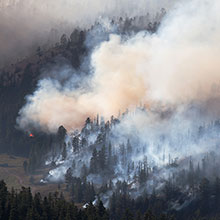Comment: Wildfires and COVID-19: a planetary health emergency
Issue: Life on a Changing Planet
11 May 2021 article

Wildfire seasons are becoming longer, more intense and more severe, causing devastating environmental and economic damage at a global scale and pushing emergency services to the brink. In 2020, wildfires raged in Western US states, Australia, India, Siberia and Ukraine, including the largest fires ever recorded in California and Colorado. These large-scale wildfires led to record-breaking air pollution levels in several areas. For instance, PM2.5 levels (PM2.5 [where PM is ‘particulate matter’] refers to particles with an aerodynamic diameter less than 2.5 µm) in California reached 453 µg m–3 compared with the safe mean annual limit of 10 µg m–3, recommended by the World Health Organization. While trying to keep the unprecedented fires under control, these countries also had to find ways to control the rapid spread of COVID-19. In several wildfire-affected areas such as Brisbane, N95 masks were in short supply, given that masks were required to protect individuals from both wildfire smoke and the novel virus.
Complex interconnections of climate change and wildfires
The year 2020 was one of the three warmest years on record, with the global mean surface temperature measured 1.2 ± 0.1 °C above the pre-industrial baseline, according to the World Meteorological Organization. Climate change is assumed to be a major cause of the increasing likelihood of wildfires, which is driving many forests into drought stress, reducing the vegetation water content. In return, wildfires drive global warming by contributing to increased CO2 emissions, resulting in a vicious cycle of global environmental change and enhanced wildfire risk. Besides causing profound environmental destruction, the impact of wildfire smoke on human health and potential synergistic health effects with COVID-19 are expected to be huge.
Influence of wildfire smoke on the human respiratory system
Wildfire smoke is a complex mixture of small particles and gases which varies depending on the weather, burning material, fire temperature and distance of smoke dispersion. Wildfire smoke components include PM2.5, volatile organic compounds (VOCs), nitrogen dioxide (NO2), sulfur dioxide (SO2) and ozone (O3). Among these, PM2.5 poses the highest risk to human health as it can penetrate deeply into the lungs due to its small particle size, causing oxidative stress and inflammatory responses. Wildfire smoke exposure can lead to increased exacerbations of asthma or chronic obstructive pulmonary disease (COPD) and a decrease in lung function. Asthma-related hospital admissions were found to increase by 6% for each 10 µg m–3 increase in PM2.5 from wildfire smoke, indicating that wildfire-associated PM2.5 might cause stronger negative health effects than PM2.5 from other sources.
Impact of fine particulate matter on COVID-19 mortality
Since the emergence of SARS-CoV-2, researchers have been concerned with identifying key environmental factors potentially driving COVID-19 dynamics. The current state of knowledge indicates a positive relationship between acute and chronic air pollution exposure and COVID-19 severity and mortality. Air quality factors can affect COVID-19 outcomes by compromising the immune system, e.g. causing an overexpression of cytokines and chemokines. A second potential mechanism occurs via aerosol dynamics of virus transmission as PM2.5 might represent a potential transport medium for SARS-CoV-2, enhancing virus survival and diffusion of virus particles. Long-term exposure to air pollution in the US was shown to be associated with an 11% increase in mortality from COVID-19 infection for every 1 µg m–3 increase in air pollution. Long-term exposure to particulate matter was further estimated to contribute to approximately 15% of COVID-19 mortality worldwide. These findings emphasise the potential role of fine particulate matter in modifying COVID-19 mortality risks, indicating the critical need to monitor air pollution levels and issue warnings and recommendations when PM2.5 levels exceed dangerous limits.
Compound effects of COVID-19 and wildfires on human health
PM2.5 from wildfire smoke can compromise the immune system and contribute to increased respiratory symptoms, which in turn increase the risk of COVID-19 complications. Wildfire smoke exposure might also increase the likelihood of comorbidities, including cardiovascular diseases, respiratory diseases, diabetes and hypertension, leading to an increased COVID-19 risk. Higher daily average PM2.5 concentrations during the wildfire season in western US states were positively associated with increased influenza rates the following winter, indicating strong evidence for delayed effects of wildfire exposure. Research on understanding the underlying mechanisms between wildfire exposure and respiratory infection is an area of active investigation.
In particular, vulnerable population groups such as socio-economically disadvantaged populations, individuals with comorbidities and the elderly face higher risks of experiencing the combined consequences of COVID-19 and wildfires. In the US, migrant farmworkers who were continuously exposed to wildfire smoke and deemed essential workers during the pandemic faced much higher risks of severe health consequences from wildfire smoke and COVID-19. The combined impact of wildfire smoke and COVID-19 needs more attention to effectively adjust mitigation strategies to protect the most vulnerable, especially in regions with high levels of wildfire-associated air pollution.
Further reading
Arriagada NB, Horsley JA, Palmer AJ, Morgan GG, Tham R et al. Association between fire smoke fine particulate matter and asthma-related outcomes: systematic review and meta-analysis. Environ Res 2019; 179:108777.
Landguth EL, Holden ZA, Graham J, Stark B, Mokhtari EB et al. The delayed effect of wildfire season particulate matter on subsequent influenza season in a mountain west region of the USA. Environ Int 2020;139:105668.
Pozzer A, Dominici F, Haines A, Witt C, Münzel T et al. Regional and global contributions of air pollution to risk of death from COVID-19. Cardiovasc Res 2020;116:2247–2253.
Reid CE, Maestas MM. Wildfire smoke exposure under climate change: impact on respiratory health of affected communities. Curr Opin Pulm Med 2019;25:179–187.
Wu X, Nethery RC, Sabath MB, Braun D, Dominici F. Air pollution and COVID-19 mortality in the United States: strengths and limitations of an ecological regression analysis. Sci Adv 2020;6:eabd4049.
Gosling SN, Bryce EK, Dixon PG, Gabriel KMA, Gosling EY et al. A glossary for biometeorology. Int J Biometeorol 2014;58:277–308.

Rosa von Borries
Consultant at World Meteorological Organization, Bernhard-Lichtenberg-Str 15, 10407 Berlin, Germany
[email protected]
@rosavborries
linkedin.com/in/rosa-von-borries-5b4987197
Rosa von Borries holds an MSc in Public Health from London School of Hygiene and Tropical Medicine. She is employed as a Consultant at the World Meteorological Organization, working with the WMO COVID-19 Task Team, the Scientific Advisory Panel and the WHO-WMO Study Group on Integrated Health Services.

Rachel Lowe
Associate Professor and Royal Society Dorothy Hodgkin Fellow at London School of Hygiene and Tropical Medicine, Keppel Street, London WC1E 7HT, UK
[email protected]
@drrachellowe
Rachel Lowe leads a group of researchers working between the Centre for Mathematical Modelling of Infectious Diseases and the Centre on Climate Change & Planetary Health at the London School of Hygiene & Tropical Medicine. She is interested in how extreme weather events interact with socio-economic factors to impact the timing and intensity of infectious disease outbreaks.
Image: Forest Fire in Dixie National Forest, Utah, USA. santirf/iStock.


